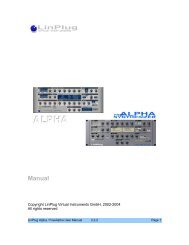CrX4 User Manual - LinPlug Virtual Instruments
CrX4 User Manual - LinPlug Virtual Instruments
CrX4 User Manual - LinPlug Virtual Instruments
Create successful ePaper yourself
Turn your PDF publications into a flip-book with our unique Google optimized e-Paper software.
The Envelopes are positioned in each Filter, the Main Section and the<br />
Modulation Section (Gen/Mod Envelope). All six envelopes are exactly the<br />
same. They can be of ADSFR type or of AHDSR type, which means:<br />
ADSFR : Attack, Decay, Sustain, Fade, Release<br />
(classic ADSR plus the sustain can either fade in or out)<br />
AHDSR: Attack, Hold, Decay, Sustain, Release<br />
(classic ADSR plus a Hold phase which determines a time span<br />
between end of Attack and start of Decay).<br />
The Envelope type is switched with the Filter Type button at the top right of<br />
each envelope. This button either reads “...F.“ for the ADSFR or “.H...” for<br />
the AHDSR<br />
Clicking on the Edit button at the right of the Filter Type button opens a<br />
popup menu containing the following functions: “Copy”, “Paste” and “Init”.<br />
The “Copy” and “Paste” functions allow current Envelope settings to be<br />
copied and pasted into any Envelope module. The Init (“Initialization”)<br />
function restores the Envelope module to its default values.<br />
Note: You can copy between different envelopes of a patch, between<br />
different patches (the copy buffer is preserved when loading new patches)<br />
and between multiple instances of <strong>CrX4</strong> which are simultaneously open.<br />
Envelope Parameters<br />
Attack<br />
The Attack dial determines the time it takes for the envelope to reach its<br />
maximum value. The range is 0 millisecond to 10 seconds.<br />
If used for Amplitude, it means that the Envelope takes so long to reach the<br />
maximum Amplitude, for the Filters it takes so long to reach maximum<br />
Cutoff (or minimum Cutoff when Envelope Depth is inverted, more about<br />
this in the Filter description).<br />
Hold<br />
If the AHDSR envelope is used, this dial controls the time gap between end<br />
of the Attack phase and start of the Decay phase. In classic ADSR<br />
envelopes these phases are connected, as soon as Attack is finished,<br />
Decay will start. With the Hold parameter however the envelope can remain<br />
at maximum level for a certain amount of time. The effect of that is<br />
<strong>CrX4</strong> <strong>User</strong> <strong>Manual</strong> 45












